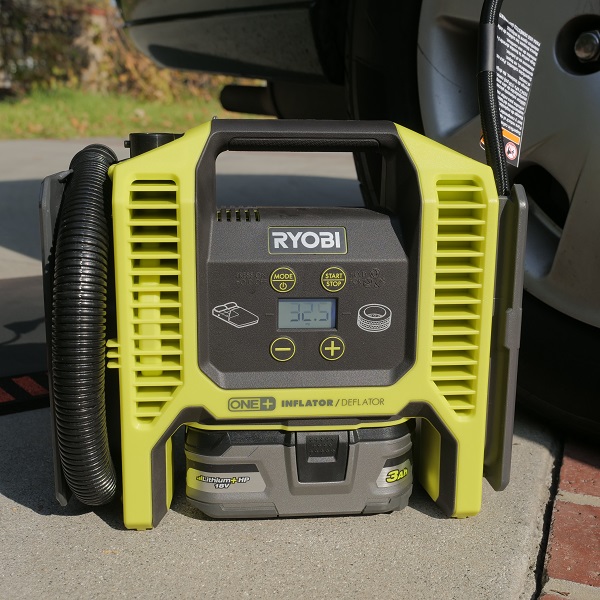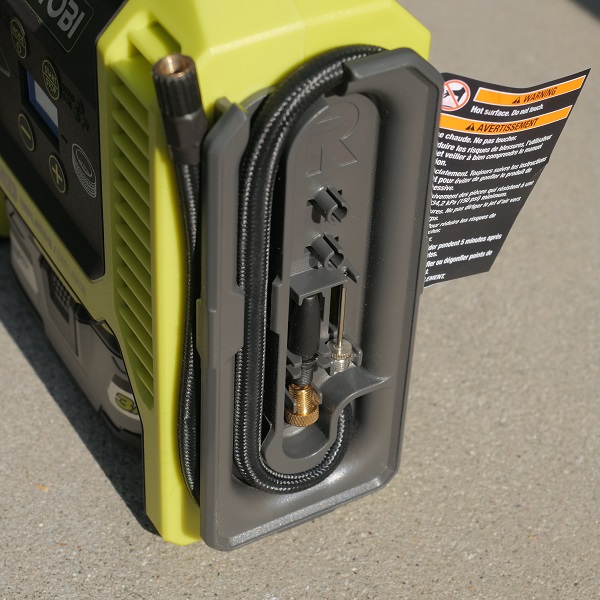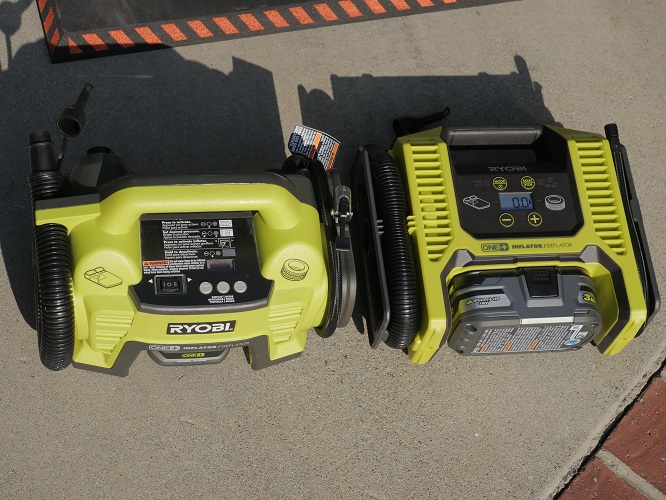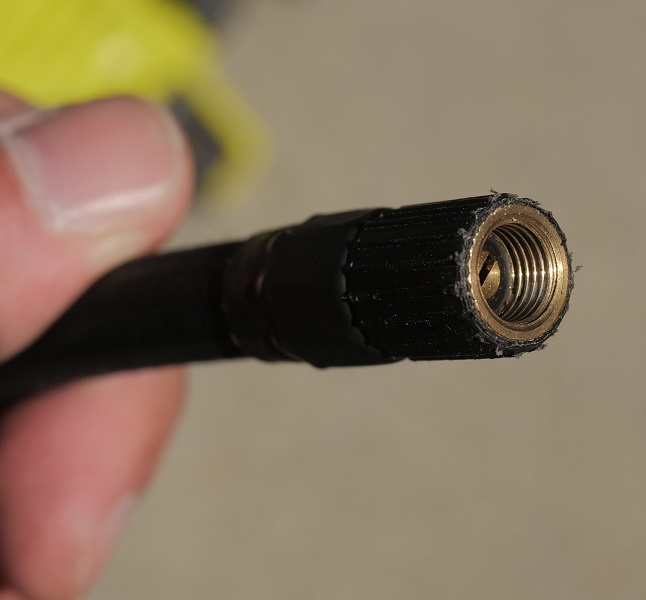Ryobi launched the original P731 cordless 18V inflator deflator years ago and it was great because not only did it inflate tires and air mattresses, but it had the ability to program the desired PSI and let the inflator take care of the rest with it’s autofill/auto shutoff funtion. Ryobi felt the P731 was showing it’s age and decided to replace it with a newer model, the P747 cordless 18V inflator deflator model. In this article, we’ll be reviewing the new P747 inflator/deflator and will also be comparing it to the original P731 model and also the very similar Dewalt 20V DCC020IB corded/cordless inflator/deflator.
ETHICS DISCLOSURE:
Ryobi was kind enough to provide the Ryobi 18V P747 Inflator Deflator at no cost for review. As with all my reviews, I am not paid, sponsored, or obligated to give a positive review. This review is my opinion of the product based on my usage and knowledge and my review will reflect what I like and dislike about the product. I will do my best to provide you with an unbiased review.
MANUFACTURER SPECS:
- Autofill shutoff for hands free inflation
- High volume inflation/deflation for large inflatables like air mattresses and pool toys
- Easy view precision digital gauge for easy, accurate, pressure readings
- Brass threaded tire chuck for durability and ease of use
- Cordless for convenient use in virtually any location
- Inflates a car tire from flat to full in 4 minutes (using P108 4.0 Ah LITHIUM+ Battery, not included)
- Inflates twin air mattresses in 30 seconds (using P108 4.0 Ah LITHIUM+ Battery, not included)
- Onboard storage for accessories
- Part of the RYOBI ONE+ World’s Largest 18-Volt Tool System*
- 3-year manufacturer’s warranty
- Includes: (1) P747 18-Volt ONE+ Inflator, high pressure hose, high pressure nozzle, Presta valve adaptor, sports ball needle, high volume hose, pinch valve nozzle, and operator’s manual
- $49.98 price at time of writing
FEATURES:
The Ryobi 18V P747 Inflator Deflator features all of what made the original P731 great as it has the ability to inflate tires and sports balls with it’s high pressure side and can also inflate and deflate high volume/low pressure inflatables like air mattresses, beach balls, etc. It has an integrated LCD to select between the high pressure and high volume modes and when inflating using the high pressure hose, the display shows you the current tire pressure in PSI. From here you can use the + and – buttons to set your desired PSI you want to fill the tires to. Using the +/- buttons, a single tap increases or decreases PSI in single PSI increments while holding either button increases or decreases PSI very quickly in 5 PSI increments. You can set PSI from 2 all the way to 150 PSI. From here you can press start to commence. This inflator takes care of all the work so you can set it and forget it and the inflator will automatically stop when it reaches the chosen pressure. The LCD is also backlit so you can easily see the display at night. You can also use the high pressure hose to inflate sports balls and road bikes with the included on board adapters.
The way the deflator works is simple, the high volume side basically uses a blower to blow and pull air. The blower output is what inflates and there’s an intake port that functions just like a vacuum. Connect the high volume hose here and connect it to your air mattress to deflate much faster than it can on it’s own.
P747 Compared to the P731:
The new P747’s biggest difference compared to the original P731 is the cosmetics. From a quick glance you’ll notice the P747 model has a drastic change compared to the original. It has been streamlined and is now much slimmer but a little bit taller whereas the P731 is bulkier overall. I liked how the display is on the top on the older P731 model which makes it easy to view when in use however they place the display on the front facing out and not up on the new P747 model. When the unit is standing, it’s impossible to view the display when operating however that’s because the P747 is not designed to operate standing upright. It’s designed to operate on it’s back so the front and display is facing upwards towards you for easy viewing. One thing I didn’t like about the original model was that it used very flimsy and cheap foam pads on the bottom. The problem with these was that they are cheaply glued on and eventually one of them fell off and now my unit wobbles as it stands. They fixed this issue on the new P747 model as it has built in rubber pads on the backside and are integrated into the body so you don’t have to worry about them falling off.
While the P731 had a single rocker/toggle switch to operate/switch between high pressure and high volume modes, the new P747 unit ditches the old rocker switch in favor for a single button that turns the unit on to view the display and can toggle between modes. When the unit is off, a single tap turns the unit on and puts it into the high pressure tire inflation mode. Pressing the button again toggles between the modes and a holding the button turns the unit off. To operate either mode when the unit is on, there’s a separate start/stop to use either mode.
They also upgraded the high pressure tire hose connector on the P747 model as it now has a screw on connector. This is easier to use than the old clamp on connector and doesn’t lose as much air pressure as the clamp connector when disconnecting from the tire. The high volume hose was very flimsy on the original model and has now been upgraded slightly by making it a bit sturdier on the newer model. It’s still flimsy on the new unit however but now just not as much as before.
Another difference is the battery angle placement. While the battery is on the bottom of both units, the battery was in the front to back orientation on the old unit and is now sideways on the new unit. This may not seem like a big deal but you can’t check the remaining battery charge on the new unit without having to remove the battery to do so since you can’t access the battery’s fuel gauge when it’s installed.
Regarding performance between the new model and old model, the high pressure inflation speed is the same. I tested this by having both units inflate a dolly/hand truck tire from empty to 30 PSI and both units did this test in exactly 21 seconds. So no difference in inflation speed. I did notice that the newer unit was a bit louder than the old unit. The old unit was a steady 88 decibels while the new unit was between 92-94 operating decibels loudness. Another performance difference I noticed was that the older unit would over inflate by exactly one PSI while the newer P747 model stops exactly at the set PSI. I’m not sure exactly why this is but I believe it has to do with the hoses they use. Since the older unit uses a clamp on hose which loses more air when disconnecting, I believe this is why the old model over fills by one PSI to compensate for the loss of pressure when disconnecting it’s hose. Because the new model uses a better connection that doesn’t lose much are when disconnecting, it doesn’t really need to overcompensate by over filling. This is my theory but there could be other reasons for this.
So should you buy the new model over the older one? Actually you couldn’t buy the old P731 unit even if you wanted to as they’ve discontinued it in favor for the newer P747 model so your only choice between the two is the new model. If you own the old model, should you upgrage to the new model? They are both so similar that unless you want the new screw on hose connector and the new streamlined design, I’d say stick with the old one as they are both very similar and can do the same thing. The older unit actually has a couple of advantages as it runs quieter (not by much) and you can check the battery fuel gauge while the battery is installed. However the new model doesn’t have cheap flimsy foam pad feet you’d ever have to worry about falling off eventually.
P747 compared to the Dewalt 20V DCC020IB:
Both units are very similar as they can both inflate tires and inflate and deflate high volume inflatables and have LCD screens and the autofill shutoff mode. Both units also run on battery power making them both cordless. But that’s where the similarities end. In addition to being battery powered, the Dewalt 20V inflator can also be plugged in via it’s included 12V DC cord and plug that connects to your vehicles 12V DC cigarette port. This difference means you don’t need to bring a battery along to use with a vehicle. The Dewalt also has a built in LED light. It’s not the brightest but it sure does come in handy if doing roadside work at night. While I owned the Dewalt unit, I had a flat tire and had to change my tire and of course it had to happen at night. The LED light was very helpful in this situation.
The differences don’t end there as the fit and finish is of higher quality on the Dewalt. For example the flimsy high volume air mattress hose on the Ryobi, is a lot beefier and sturdier on the Dewalt. Although with that being said, even the very flimsy high volume hose on the original P731 is still holding up today even after several years of ownership. The Ryobi’s use a braided high pressure hose while the Dewalt uses a nice rubber hose and the connector appears to be solid brass. The Ryobi connector appears to have some brass in the center but has a plastic sleeve. The Dewalt has more rubber overmolding and beefier too and has a roll cage design for further impact protection.
The Dewalt unit also has a double display so you can see your tires actual pressure in one display and the set PSI in the other display. The two displays work together and the live feed pressure display has a half dial gauge which shows you how far you are from reaching the desired PSI pressure. For example, if you set the PSI to 30 PSI the dial or bar will be empty when the actual tire PSI is 0 but as the tire fills up, so will the bar gauge. When the PSI reaches 15 PSI which is half of 30, the gauge will be half full and fills up more and more as the actual pressure reaches the chosen PSI.
As far as performance is concerned between the two, the Dewalt is a bit stronger at high pressure inflation. I ran the Dewalt under the same empty to 30 PSI dolly tire inflation test and it completed the test in 18 seconds which is 3 seconds faster than the Ryobi’s. It’s not that much faster or stronger but the small difference can add up when filling up much larger tires. The Dewalt is also a little bit quieter at 86-89 decibels loudness. Just like the newer P747 model, the Dewalt also doesn’t over fill when set and stops exactly at the desired PSI.
There’s also a huge price difference between the two. The Ryobi P747 model at $49.98 (baretool) is less than half the price of the Dewalt which is at $109 (baretool) at the time of writing. While the Ryobi P747 doesn’t have the option to plug into your car and doesn’t have a light, it’s much more affordable than the Dewalt and a lot easier on your wallet.
So should you get the Dewalt over the Ryobi P747? That depends on you if you want the extra features such as the corded plug in ability and the LED light, the better build quality and slightly better inflation and quieter performance but it does come at the expense (literally) of more than double the $$$. The Ryobi is the winner when it comes to value and price while the Dewalt is the winner when it comes to bells and whistles.
Ryobi P747 Pro’s:
- battery powered portable inflator/deflator
- Backlit LCD display
- can select 2-150 PSI fill pressure with autofill
- display shows current tire pressure
- screw on high pressure hose connector
- integrated rear feet bumper/pads won’t fall off like they can on P731 model
Ryobi P731 Con’s:
- battery only, not a hybrid – no plug in ability
- no LED light
- must remove the battery to view battery fuel gauge

DISCLOSURE:
We are a participant in The Home Depot Affiliate Program, an affiliate advertising program designed to provide a means for us to earn fees by linking to homedepot.com. Tool Craze does not sell this product or any product on the Tool Craze website. Tool Craze does not handle the sale of any item in any way. If you purchase something through a post on the Tool Craze site, Tool Craze may get a small share of the sale. Please refer to the About section for more info.







My CIT1800G failed after 6 years of very little use… I pulled it apart and as I look at it I concluded that it was a design failure. The light bronze sleeve on the compressor camshaft was totally flogged out and it’s associated drive spindle had worked loose. Consequently the reduction gears to not remain engaged under load. Make sure you get & keep your warrantee if you buy one.
Thank you for this for this review. I’m currently on the fence about the Ryobi or the Dewalt inflator and you have answered them for me. Thank you so much for your hard work.